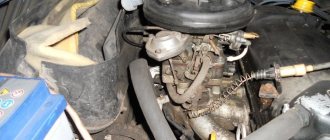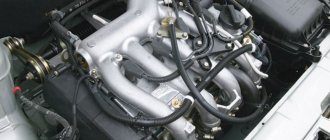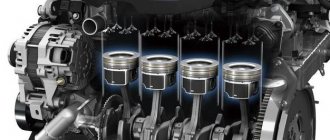Checking compression of VAZ 2106
Further, if the engine is stalling, it would be a good idea to check the compression of the idle cylinder, since its absence may be the cause of the engine stalling. How to check compression? To do this you will need a compression gauge and the help of your friend. (Compression measurement process) Compression in a new engine should be within 12 points. If the compression in an idle cylinder is less than 8 points, then this is what can cause the engine to trip. If the compression is 9-10, then you should measure it in all other cylinders. The compression in all cylinders must be +- the same and its difference by more than 1 point is unacceptable.
Why does the VAZ 2106 jerk while driving?
Your answer to the question on the topic why the VAZ 2106 car jerks while driving is interesting to us. All about renovation. Here we teach you how to repair a car yourself. How to repair a car yourself at home. We will help you with repairs and repair the car yourself. We know how to restore a car with minimal investment. I have attached video instructions.
Views: 308138
Category: Car repairs
Laughter topic: Beautiful sunny morning. An elderly man walks in a city park. A small dog runs after him. A policeman comes up and says sternly: “Put a leash on the dog!” Otherwise I will fine you! The man walks on in silence. The policeman becomes furious: “If you don’t immediately put a leash on the dog, you’ll have to pay a pretty penny!” The man moves on. The policeman takes out a notebook, writes something in it, tears off the piece of paper and hands it over: “Here is the receipt for the fine!” - Why should I pay? This is not my dog! - What? Why is she running after you?! - Well, you are also running after me.
Published by Admin: at the request of Angelyar
Reasoning of the car owner: Appearance, spacious interior, good suspension (I got into good holes a couple of times, apparently without consequences), trunk volume, ground clearance just for the city, quite enough, multimedia system and 4 good speakers
Video: why the VAZ 2106 car jerks while driving
noutavto.ru
Spark generator
The first place where motorists usually look for a problem is the spark plugs. On old domestic cars this is done simply - using the old-fashioned method. The spark plug is unscrewed from the cylinder block.
Next, it is inserted into the tip and leans against the car body. Turn the ignition key for 1-2 seconds and you will see if there is a spark. This procedure should be repeated with all four candles. Of course, if there is a stand for checking spark plugs, then it is recommended to use it.
To check the high-voltage wires, you need to remove them from the vehicle and measure the resistance using a multimeter. The indicator should be about 5 ohm. For Zhiguli cars with a carburetor engine, it is recommended to use high-voltage wires manufactured by Tesla.
The VAZ 2106 engine uses a standard Zhiguli ignition coil, which can also fail. Therefore, it is recommended to diagnose this element as well. In case of failure, replace it.
Air intake
Another component where a malfunction may be hidden is the air supply, and in the case of Zhiguli, an air filter that is simply clogged. The recommended service life of the filter element is 20,000 km. But this indicator also depends on the region of operation of the vehicle, as well as the time of year.
Rich mixture
The engine began to stall and stopped developing maximum power. When cold it may start and stall. In this case, the air-fuel mixture is to blame, where there is a lot of fuel and little oxygen.
It floods the spark plugs with gasoline and they refuse to work. From this you can judge the quality of the fuel mixture. If there is black soot, it is rich, if it is light, it is poor.
I wrote about this in detail in other articles, go to the channel, everything is written there, the link was above.
What to do
Look for the reason. There are several possible sources of problems:
- Mass air flow sensor
. It fails and the ECU receives incorrect readings for preparing the mixture. I wrote how to check it here. - The second lambda was covered with a “copper basin”
. There is also a separate article about it. - In the case of a carburetor, a high level in the float chamber
.
And so on. There can be many reasons for a rich mixture. If you are interested, I will write a separate article on this topic. Let me know about it in the comments.
Finding the cause of the tripping
We start looking for a fault, start the car, go to the exhaust pipe, listen to the sound of the exhaust. On a working engine, the sound is smooth and uniform. The fact that there is no spark on one candle is indicated by popping noises; they are repeated at certain intervals. If the popping noises are repeated at different intervals, then the reason is in the carburetor, or rather in its adjustment. Popping noises that sound at irregular intervals can be eliminated by changing the entire set of candles. Regular popping noises can be caused by poor condition of the high-voltage wires of the ignition system. High-voltage cables must under no circumstances have insulation defects, and the tips must not be oxidized. If such defects are present, then the problem may be in them. If you do not find cable defects, then you need to check the distributor cover and distributor rotor.
Unscrew the 2 fixing screws of the plastic distributor cover and remove it. Examine the lid inside and out. There should be no cracks on the cover, as well as carbon deposits, and the carbon contact should be damaged or worn out. The ends of the high-voltage cables must be removed and the spark plugs unscrewed.
When dismantling high-voltage cables, do not pull on the cable itself.
Candles need to be carefully examined and their appearance checked. The gap between the spark plug electrodes should be 0.6-0.7 mm. If the candle is smoked or damp, it can be thrown away. If no obviously faulty spark plug is found, the spark plugs can be replaced and the high-voltage cables connected. There is another way, we take a spare spark plug, attach it to the engine, the spark plug does not need to be fixed to the oil dipstick, carburetor, fuel hoses, fuel pump, or oil filler neck. If during inspection you find a malfunction in the 3rd cylinder, you will have to remove the hose.
If the interruptions (engine tripping) do not stop, then most likely you will have to check and replace the vacuum brake booster.
Source: https://avtorial.ru/VAZ2/VAZ210615.html
Ask in the comments. We will definitely answer!
Causes of malfunction
Why does the engine in the VAZ 2107 suffer from injector problems?
If the driver observes signs of malfunction in the operation of the cylinders, it is necessary to diagnose the operation of the power unit. There are five most common reasons:
- problems with the ignition system;
- violation of the formation of the working mixture;
- malfunction of the gas distribution mechanism;
- malfunction of the power steering system;
- failure of the engine itself.
I would like to say right away that there may be many more reasons. And without high-quality diagnostics, it is not always possible to determine exactly what the problem is. But in this article we will discuss the most common faults in most cases, which in 90 percent of cases drivers can detect and fix on their own.
Reason 1: problems with the ignition system
One of the main reasons for engine stalling is a failure in setting up the ignition system. If you listen carefully to how the motor operates, you can hear popping noises accompanied by slight twitching of the motor, which indicates that one of the strokes is missed.
If these signs appear at idle, but after the crankshaft is spun, the engine becomes stable, this indicates early ignition. This means you need to adjust the ignition setting.
It is important to consider that different spark plugs are suitable for different engines.
For example, you need to pay attention to the heat rating and other important design features. In rare situations, when it is not possible to urgently change the spark plugs, but you have to drive, you can temporarily clean what you have and make sure that the gap is set correctly
Checking the ignition coil (babin) of VAZ 2106
And now we have finally come to the ignition coil of the VAZ 2106. If the ignition coil is faulty, then there will not be a spark in all cylinders at once, this needs to be understood. Those. the engine will not start. How can I check it? There are several ways, but I will tell you about one, the simplest one - this is measuring the resistance of the primary and secondary windings of the coil. Let's start with the primary one. To do this, set the tester in resistance measurement mode and measure it between the “+” and “-” terminals of the coil. It should be between 0.5 and 2 ohms. If the tester does not show anything, it means the circuit is broken and the coil needs to be replaced.
Next, we measure the secondary winding - between the “+” and the central terminals of the coil. Allowable resistance is up to 15 kOhm.
This ends the high-voltage part of the KSZ and now I will make some amendments for the BSZ VAZ 2106.
The main differences are that instead of a chopper with a capacitor, a Hall sensor with a switch is installed.
Checking the distributor
And then we will check the VAZ 2106 distributor. The first thing you need to pay attention to is its cover. We remove it and inspect it for damage, cracks, etc. Through cracks, along the path of least resistance, current can flow to ground
Thus, a small voltage will already come to the spark plug or nothing at all will come, and the spark will either be weak or not exist at all
Through cracks, along the path of least resistance, current can flow to ground. Thus, a small voltage will already come to the spark plug or nothing at all will come, and the spark will either be weak or not exist at all.
Next we will talk about the remaining parts of the distributor. And they need to be considered in the event that you do not have a spark at all, or if you have one, but it is very weak. Those. if there is no spark in only one cylinder, then there is a 99% chance that the problem is not in the distributor.
After the lid, we immediately pay attention to the slider. The runner must also be intact and not have any damage. Moreover, you need to inspect it both from above and from below.
And the best way to do this is to unscrew it
Moreover, you need to inspect it both from above and from below. And the best way to do this is to unscrew it.
Next we move on to the breaker contacts. First you need to check the cleanliness of the contacts. If there is any plaque or carbon deposits, it naturally needs to be removed. It would probably be better to do this with zero sandpaper or a needle file. Next, after cleaning, you need to check the gap between the contacts. It should be 0.35-0.45mm
We take a set of probes, find a 0.35 probe and check... We also pay attention to the cams that move the contacts - they should not have significant wear and the existing wear should be the same for all cams
Next you need to pay attention to the wire that is connected to the breaker contacts. It is advisable to move it, tug it in different directions, and make sure that the wire has reliable contact. It may happen that over time, due to vibration and other things, this wire breaks off and, naturally, the contact will either be very weak or disappear altogether
And this is not often paid attention to
It may happen that over time, due to vibration and other things, this wire breaks off and, naturally, the contact will either be very weak or disappear altogether
And this is not often paid attention to
The next logical step is to check the capacitor. The simplest thing is to measure its capacity. It should be within 0.25 µF. But for this, of course, you will need a tester with a capacitance measurement mode. I don’t have this, so I’ll tell you about the second method. We disconnect the capacitor wire and the wire coming from the coil from the distributor breaker and connect a light bulb (12V) between them. Afterwards, turn on the ignition and look at the light bulb - if it is on, it means the capacitor is broken and needs to be replaced. If it doesn’t light up, then everything is fine with the capacitor.
In the same way you can do without a light bulb. Instead of connecting the light bulb, we simply short-circuit the wires with each other, with the ignition on, of course. If it sparks, the capacitor is broken.
Troubles VAZ engine when cold
When the problem occurs exclusively during warm-up of the internal combustion engine, you need to pay attention to the following components:
- Mass air flow sensor;
- Air leaks in cold parts, after reaching operating temperature, leaks are blocked by expanded material;
- Injectors - cold design may stick;
- Airing of the highway. In some cases, after inactivity, air bubbles form inside the hoses.
After the system warms up, the plugs come out on their own, due to which the engine is leveled.
Bottom line
The negative effect when a VAZ engine fails can be removed independently. The design of the power plant does not have complex parts or systems requiring highly specialized equipment. For proper repairs, it is enough to have a minimum set of tools and have basic knowledge of the internal combustion engine.
Ignition timing failure
When it is impossible to determine the exact position of the inoperative cylinder, the ignition timing system should be checked. In injection engines, the ignition is controlled by an electronic unit,
therefore, the correctness of its operation can only be determined by computer diagnostics. You can continue troubleshooting by eliminating this cause.
The fuel mixture is prepared from gasoline and air. Their quantitative composition affects the operation of the Chevrolet Niva engine. The lack of air is usually due to a clogged air filter.
Excessive amounts indicate a “suction”. On this car, air leaks often occur at the attachment point of the vacuum brake booster pipe,
but don't forget about the throttle position sensor.
The mixture may be of poor quality due to clogged nozzles. Worn o-rings cause depressurization of the fuel system or air leaks. The solution to this situation is to replace the injector seals.
Incorrect operation of injectors
If your car has distributed or direct injection, then the cause of the engine tripping may be a malfunctioning fuel injector. It may overflow or not inject gasoline into the intake manifold or directly into the combustion chamber.
You can check the performance of the injectors at the stand. In the garage - just swap them and watch the scanner readings for errors.
A stand for testing the performance of fuel injectors when searching for the causes of engine tripping
Fuel supply
Fuel supply is one of the important elements in the formation of the air-fuel mixture. Let's consider where a malfunction can occur. The following elements should be diagnosed: carburetor, fuel pump, fuel filter and intake manifold.
Let's start with the most common cause of tripping - the carburetor. It has a float chamber where the float can break, blocking the normal supply of fuel. Because of this, a lean mixture is obtained, which actually leads to triplication.
To fix the problem, you will have to disassemble and rebuild the carburetor. To carry out restoration and repair operations, a repair kit is usually used, which can be purchased at any car market.
The fuel pump, or rather its malfunction, can lead to poor fuel supply. Of course, to fix the problem, you can buy a repair kit and rebuild the unit. But, as practice shows, the repair will not last long, and it is recommended to replace the unit. Also, it is worth replacing the fuel filter, which is located near the gasoline pump.
A crack in the intake manifold can lead to air leaks, which will lean the mixture and lead to the effect of a throttled power unit.
In order to inspect the part, you will need a pit or a lift, since the lower part of the collector can only be seen from the side of the car pan. If it is determined that the part has a crack, it must be removed from the machine and welded using argon welding.
Valve mechanism
The last place to look for a problem is the valve mechanism and piston system. Usually, in this case, the car owner is advised to contact a car service center.
But the VAZ 2106 engine has a fairly simple design, so it’s easy to figure out and identify a fault of this nature, although it will take half a day.
To simultaneously inspect the condition of the cylinders and valves, you will have to dismantle the cylinder head. To do this, it is worth removing the carburetor, manifolds and other equipment from the engine that is attached and will interfere with the dismantling process. Then, it is worth inspecting the condition of the intake and exhaust valves, as well as the valve seats.
The cylinder head may need major repairs. Also, it is worth looking at the condition of the pistons and oil rings. The pistons could burn out or the engine's life would be exhausted. To fix it, it is necessary to overhaul the engine.











